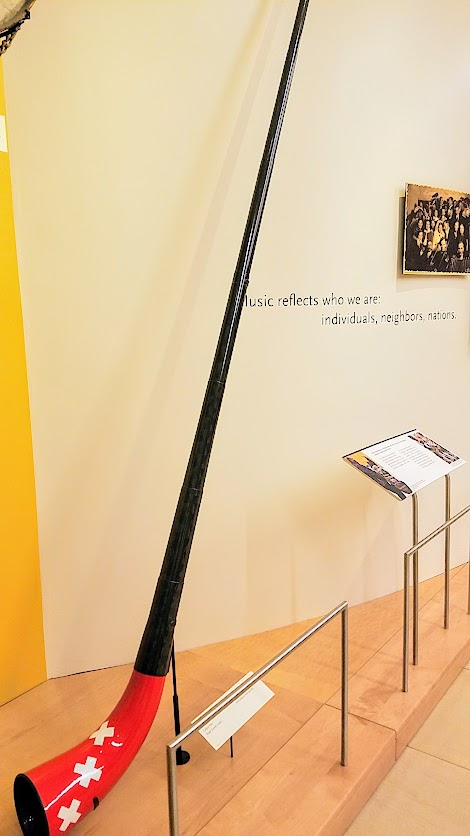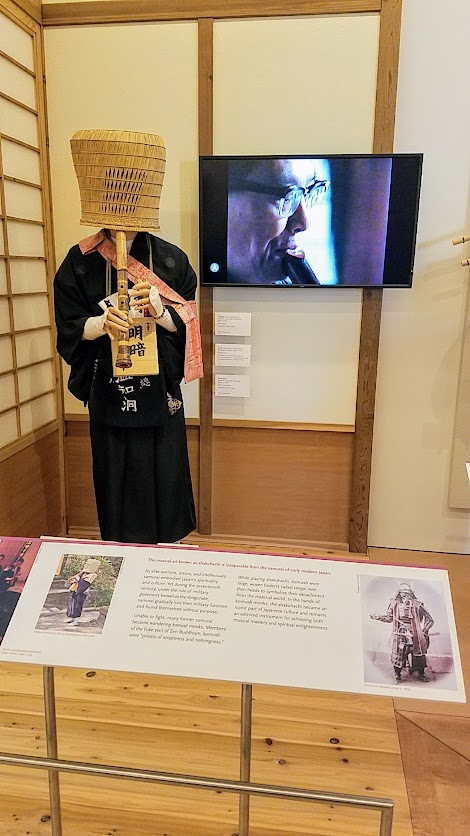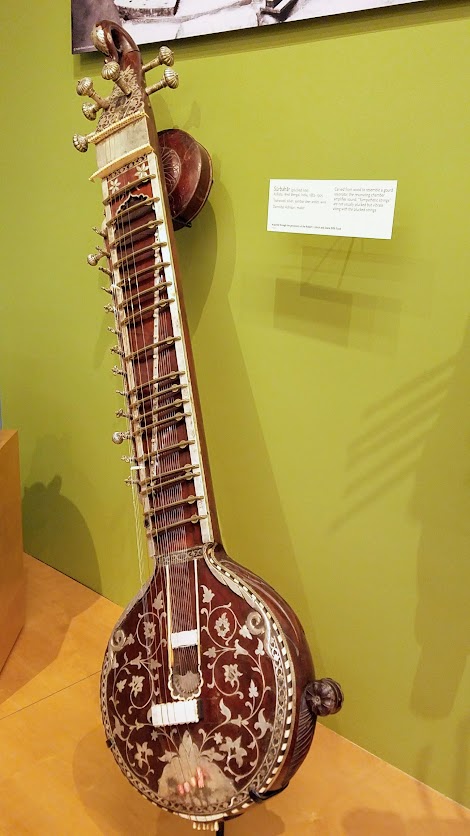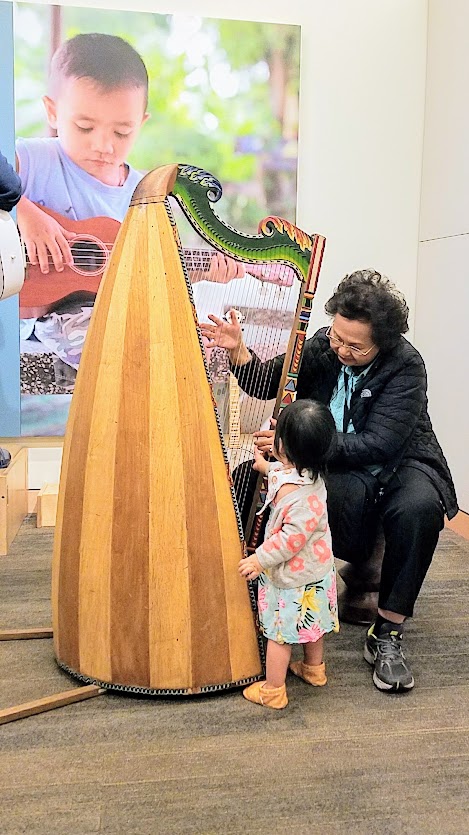For Thanksgiving 2017, I pitched (and the family agreed!) to get together in Sedona. All of us flew into Phoenix from the various cities we live in (Portland, LA, Bay Area, Chicago) and so we had some time in Phoenix bookending our time in Sedona. One of the ways we passed the time was the new to us Musical Instrument Museum, aka MIM. There are not many music instrument museums, and most are in Europe. MIM further prides itself on being representative of global music. It’s definitely worth a visit – let me show you why!


Built in 2010, MIM offers 15,000 musical instruments and associated objects from nearly 200 countries around the world. After purchasing your admission ticket ($20 1-day or a discounted $30 2-day that you must use the second visit within a week), you will also receive a headphone with volume control unit for each person in your group. Most exhibits features a TV with multiple videos cycling for a minute or so. The videos vary from showing local musicians of a county performing their native music, often in native dress, sometimes including native dance, to just demonstrating how the instrument was made or how it works. The headphones automatically sync with each of those TVs when you are in proximity to it.

The videos really help bring to life the instruments that may be on display for that country. It really sets this museum apart from other music museums with the multimedia helping you see the instruments in action and how the music sounds unique from others instruments or the same instrument from another country – but also has fascinating similarities despite the miles and language barriers in between.






MIM is irganized into 2 floors with the second floor housing the Geographic Galleries, grouping displays by continents, and then country, and then possibly subcategories from there. For instance, in the United States section, besides highlighting music from different regions and times in history, they had a pretty detailed section on Native American music.
This initial area highlighted differences in Big Drum music (music played in unison by number of players, often present at pow-wows) and their costumes and dance beyond their music. For instance Northern Big Drum music tends to be faster tempo and higher nasal pitch and drums are fur-covered, while Southern is slower and lower vocal range with drums from buckskin or sheepskin. A separate TV showed different competition level pow-wows.





Details behind the instruments were also included among the exhibits, with very informative longer videos with instrument makers explaining what is inside and where the materials all come from, and how they are assembled.




There was no country that didn’t seem to make an appearance in the Geographical Gallery, and there was something mesmerizing yet overwhelming at how much music has found its way to every culture anywhere, anytime. Everyone had found their their own way to make music with their own percussion instruments, their own wind instruments, their own stringed instruments, etc.




Many countries, I was able to for the first time hear their music and how they celebrate, or mourn. I learned how some cultures use music as entertainment, or to bring courage in battle, or communicate across areas (like Democratic Republic of the Congo’s use of drums between villages) or even bridge the realm between the magical and real world with bells and rattles to ward off evil spirits and call good spirits.


Music is for everyone, rich or poor. There was creativity in creating instruments from whatever materials were available, even from literal objects lying around and even what would be garbage: cigar boxes, ice buckets, whiskey jugs, bottle caps and sticks, bones, wood, reeds, shells, and scrap metals.






One of the photos above is a Mihbaj, mortar and pestle, from the Bedouin people; mulberry and bootoom wood, metal. Used by Bedouin men to crush coffee beans and to play rhythmic accompaniment for songs and dances
And there were plenty of examples of extremely exquisite craftsmanship, the labor of love to make this instrument of expressing emotion as unique as an individual person.







The first floor of MIM has a performance auditorium and also has special exhibits. One hall during our visit showcased ancient Chinese musical instruments, while another had an exhibit on contemporary music icons varying from Elvis to Ravi Shakar to Carlos Nakai to Taylor Swift.




Another hall was the Mechanical Music Gallery, musical instruments which play themselves. This varied from ornate detailed music boxes, to boxes with birds that chirped, to player records or an Apollonia Organ comprised of a whole band of instruments.




The first floor is also home to the Experience Gallery, where you can try your hand at playing instruments yourself from around the world. If you have kids, you should resolve to spending possibly an hour here letting them bang and string it out!




Parking here is free, and if it’s a hot day this is a great way to pass the time waiting for the cooler evenings. They offer a cafe if you need a bite, and a couple seats in the main hallway areas but mostly you will be on your feet. It is very accessible – there is an elevator between floors and it is otherwise quite flat. If you have kids, check out the MIMKids schedule to see what activities they may have during the day that you may want to schedule your visit around.
For us we visited here over 2 days, 4 hours the first visit before Thanksgiving, and that a second visit while killing time waiting to go to the airport for our evening flights after checking out after Thanksgiving. It can almost be overwhelming seeing all the thousands of instruments from around the world and all the videos – there are thousands of hours of videos if you really wanted to see it all. So you will have to choose wisely on what areas interest you the most. Even over our two days of visiting we inevitably got museum fatigue, even though everything was so interesting.
Have you been to Phoenix? What were your favorite attractions? Have you heard of or been to the Music Instrument Museum before, and if not would you want to go? What musical instrument section would you be most interested in seeing?














Wow, what a cool museum I’ve never heard of! I love that the videos synch with headphones so everyone can move at their own pace.
Definitely nice to have individual volume control and it also ensures the Museum is full of music but they never interrupt or conflict with each other, really quite clever
What a cool museum! I love this sentence: “Music is for everyone, rich or poor.” Very true, and I can imagine that this museum would require multiple visits in order to take in everything. I had no idea this was in Phoenix!
It is surprising that it’s not more famous, still seems like a hidden gem!
Love this different post – how cool! 🙂
Thanks!
Such a unique and fun museum. I love learning about new (and old) instruments!
It was a lot more fun then I initially anticipated
I was unaware of this museum but I’m glad I know about it now. It’s wonderful to see instruments from around the world – was the gamelan intact (were all the pieces there)? I studied Balinese Gamelan and dance in college for a year and found it hugely satisfying – that one looks like it might be from Java. If I’m ever in Phoenix, I will definitely make a visit.
I am not familiar so not sure if all of the pieces were there – you’ll have to investigate yourself and report back!